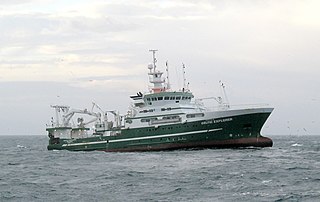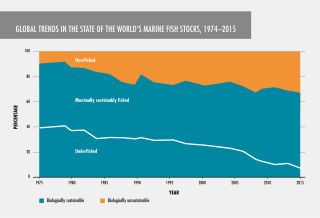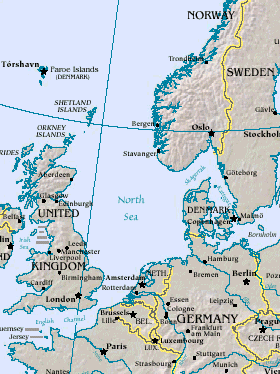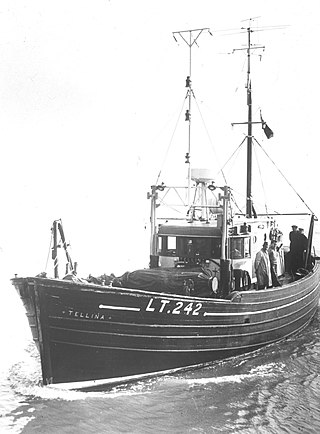
Trawling is an industrial method of fishing that involves pulling a fishing net, that is heavily weighted to keep it on the seafloor, through the water behind one or more boats. The net used for trawling is called a trawl. This principle requires netting bags which are towed through water to catch different species of fishes or sometimes targeted species. Trawls are often called towed gear or dragged gear.

Bycatch, in the fishing industry, is a fish or other marine species that is caught unintentionally while fishing for specific species or sizes of wildlife. Bycatch is either the wrong species, the wrong sex, or is undersized or juveniles of the target species. The term "bycatch" is also sometimes used for untargeted catch in other forms of animal harvesting or collecting. Non-marine species that are caught but regarded as generally "undesirable" are referred to as "rough fish" and "coarse fish".

Bottom trawling is trawling along the seafloor. It is also referred to as "dragging". The scientific community divides bottom trawling into benthic trawling and demersal trawling. Benthic trawling is towing a net at the very bottom of the ocean and demersal trawling is towing a net just above the benthic zone. Bottom trawling can be contrasted with midwater trawling, where a net is towed higher in the water column. Midwater trawling catches pelagic fish such as anchovies and mackerel, whereas bottom trawling targets both bottom-living fish (groundfish) and semi-pelagic species such as cod, squid, shrimp, and rockfish.

Seine fishing is a method of fishing that employs a surrounding net, called a seine, that hangs vertically in the water with its bottom edge held down by weights and its top edge buoyed by floats. Seine nets can be deployed from the shore as a beach seine, or from a boat.

Fish stocks are subpopulations of a particular species of fish, for which intrinsic parameters are traditionally regarded as the significant factors determining the stock's population dynamics, while extrinsic factors are traditionally ignored.

Demersal fish, also known as groundfish, live and feed on or near the bottom of seas or lakes. They occupy the sea floors and lake beds, which usually consist of mud, sand, gravel or rocks. In coastal waters they are found on or near the continental shelf, and in deep waters they are found on or near the continental slope or along the continental rise. They are not generally found in the deepest waters, such as abyssal depths or on the abyssal plain, but they can be found around seamounts and islands. The word demersal comes from the Latin demergere, which means to sink.

Pair trawling is a fishing activity carried out by two boats, with one towing each warp. As the mouth of the net is kept open by the lateral pull of the individual vessels, otter boards are not required. With the towing power of two boats and no otter boards, a larger net may be worked than would otherwise be possible, or alternatively, the two boats can share increased fuel efficiency.
The Scottish east coast fishery has been in existence for more than a thousand years, spanning the Viking Age right up to the present day.

Unsustainable fishing methods refers to the utilization of the various fishing methods in order to capture or harvest fish at a rate which sees the declining of fish populations over time. These methods are observed to facilitate the destructive fishing practices that destroy ecosystems within the ocean, and more readily results in overfishing, the depletion of fish populations at a rate that cannot be sustained.

Fishing techniques are methods for catching fish. The term may also be applied to methods for catching other aquatic animals such as molluscs and edible marine invertebrates.
Discards are the portion of a catch of fish which is not retained on board during commercial fishing operations and is returned, often dead or dying, to the sea. The practice of discarding is driven by economic and political factors; fish which are discarded are often unmarketable species, individuals which are below minimum landing sizes and catches of species which fishermen are not allowed to land, for instance due to quota restrictions. Discards form part of the bycatch of a fishing operation, although bycatch includes marketable species caught unintentionally. Discarding can be highly variable in time and space as a consequence of changing economic, sociological, environmental and biological factors.

Fishing in the North Sea is concentrated in the southern part of the coastal waters. The main method of fishing is trawling.
This is a glossary of terms used in fisheries, fisheries management and fisheries science.
Destructive fishing practices are fishing practices which easily result in irreversible damage to habitats and the sustainability of the fishery ecosystems. Such damages can be caused by direct physical destruction of the underwater landform and vegetation, overfishing and indiscriminate killing/maiming of aquatic life, disruption of vital reproductive cycles, and lingering water pollution.

The coastline of the Russian Federation is the fourth longest in the world after the coastlines of Canada, Greenland, and Indonesia. The Russian fishing industry has an exclusive economic zone (EEZ) of 7.6 million km2 including access to twelve seas in three oceans, together with the landlocked Caspian Sea and more than two million rivers.

Plaice is a common name for a group of flatfish that comprises four species: the European, American, Alaskan and scale-eye plaice.

The Community of Arran Seabed Trust (COAST) is a registered Scottish charity based on the Isle of Arran, the largest island in the Firth of Clyde. Established in 1995 by two local divers (Howard Wood and Don McNeish) COAST has been a registered charity since 2011 and is run mostly by Arran residents, who all share the same aims to protect the health of the marine environment around the Isle of Arran and within the Firth of Clyde from indiscriminate commercial fishing methods. COAST values the marine biodiversity around the shoreline of Arran and aims to regenerate and protect it for future generations.

The fishing industry in Denmark operates around the coastline, from western Jutland to Bornholm. While the overall contribution of the fisheries sector to the country's economy is only about 0.5 percent, Denmark is ranked fifth in the world in exports of fish and fish products. Approximately 20,000 Danish people are employed in fishing, aquaculture, and related industries.
The South African Deep-Sea Trawling Industry Association (SADSTIA) represents the trawler owners and operators active in the offshore demersal trawl fishery for hake, the most valuable of South Africa's commercial fisheries, contributing approximately 45 percent of the value of fishery production. Based in Cape Town, South Africa, SADSTIA currently has 32 members that catch, process and market the Cape hakes, Merluccius paradoxus and Merluccius capensis as well as several bycatch species.

RV Tellina (LT242) was a fisheries research vessel that was operated by the Ministry of Agriculture, Fisheries and Food - Directorate of Fisheries, now known as the Centre for Environment, Fisheries and Aquaculture Science (Cefas) between 1960 and 1981.

















